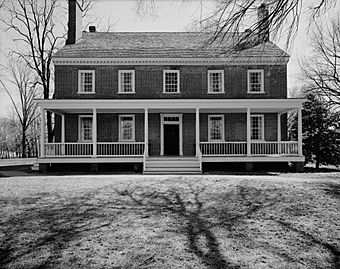Historic Locust Grove facts for kids
|
Locust Grove
|
|

Croghan Mansion at Locust Grove
|
|
| Location | 561 Blankenbaker Lane Louisville, Kentucky |
|---|---|
| Area | 55 acres (22 ha) |
| Built | 1790 |
| Architect | William Croghan |
| Architectural style | Georgian |
| NRHP reference No. | 71000347 |
Quick facts for kids Significant dates |
|
| Added to NRHP | March 11, 1971 |
| Designated NHL | June 23, 1986 |
Locust Grove is a historic farm in Louisville, Kentucky. It's like a big outdoor museum! This special place covers 55 acres and was built a long time ago in the 1700s. Today, the Louisville Metro government owns it, and a group called Historic Locust Grove, Inc. helps people learn about its past.
The most important building at Locust Grove is a large house, called a mansion, built around 1790. It was home to the Croghan family. Many famous people visited here, like George Rogers Clark, Meriwether Lewis and William Clark (from the Lewis and Clark Expedition), and even some U.S. Presidents! Besides the mansion, there's also a Visitors Center. It has a gift shop, a museum, and places for groups to meet.
Sadly, many African American people were forced to work at Locust Grove as enslaved individuals from 1790 to 1849. At one point, over 40 enslaved people lived and worked on the farm. This was a very difficult time in history.
Contents
A Look Back at Locust Grove's History
Locust Grove was started in 1790 by William Croghan and his wife, Lucy Clark Croghan. The buildings, including the big house, were built by enslaved African Americans. These enslaved people also did all the farm work, cooked, made clothes, cleaned, and cared for the Croghan children.
The Croghan Family and Famous Visitors
Lucy Clark Croghan was the sister of Brigadier General George Rogers Clark. He was a famous soldier. Lucy was also related to William Clark of the Lewis and Clark Expedition. William Croghan owned a lot of land. At its largest, the Locust Grove estate was about 700 acres!
Lewis and Clark's Return
After their long journey to the Pacific Ocean, Meriwether Lewis and William Clark returned to Locust Grove on November 8, 1806. Lucy Clark Croghan and her family welcomed them home. Locust Grove is the only house still standing west of the Appalachian Mountains that sheltered Lewis and Clark. In 2006, Locust Grove celebrated 200 years since their return.
George Rogers Clark's Later Years
George Rogers Clark lived at Locust Grove during the last years of his life. He stayed there from 1809 until 1818.
Neighbors and Mammoth Cave
Locust Grove was next to Springfield, the home of Colonel Richard Taylor. Colonel Taylor's son, Zachary Taylor, later became a U.S. President!
After William Croghan passed away, his son, John C. Croghan, took over the estate. John C. Croghan is famous for buying Mammoth Cave in 1838.
In 1844, an enslaved African American man named Stephen Bishop created a map of Mammoth Cave. His map was published in 1845. It was the best and most accurate map of the cave for many years. Later, in 1972, explorers found a new way to connect two parts of the cave. This new route was in an area that Stephen Bishop had already mapped!
Locust Grove was named a National Historic Landmark in 1986. It's important because it's one of the few remaining homes connected to George Rogers Clark.
Images for kids
See also











